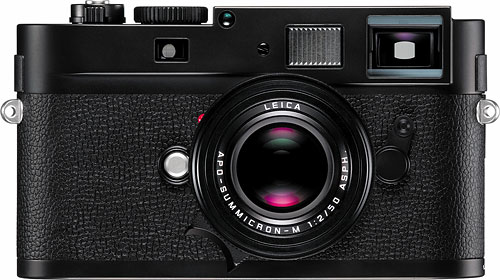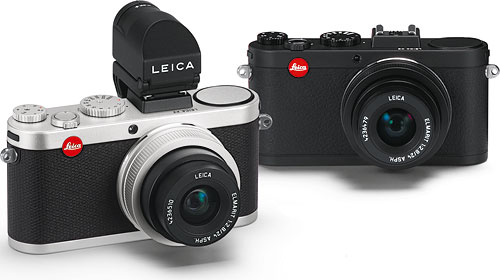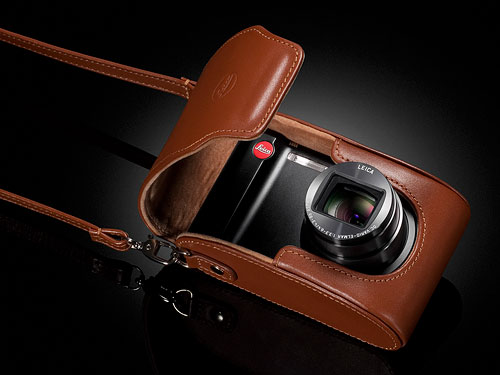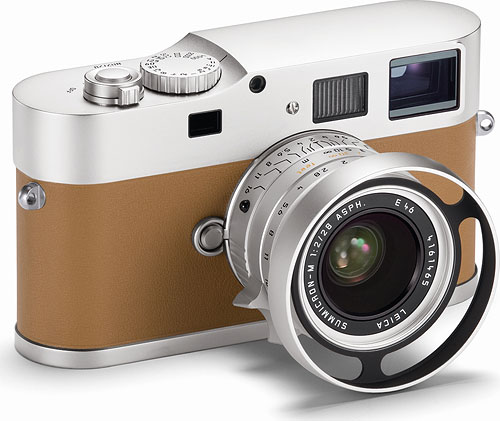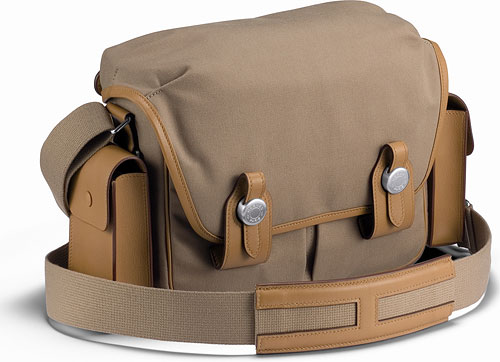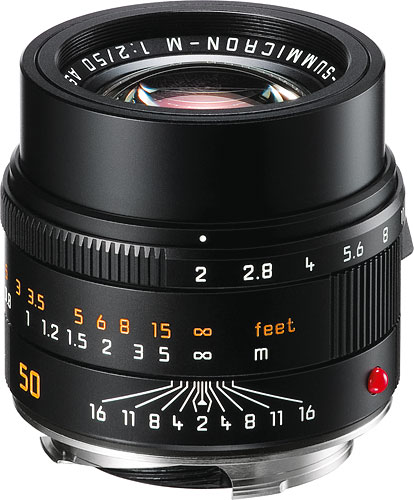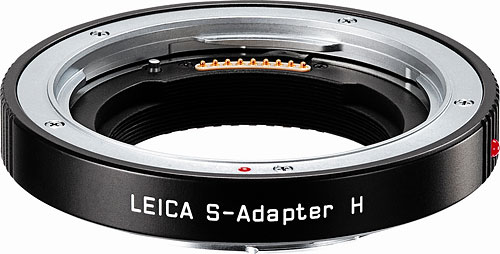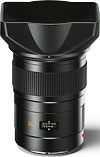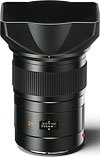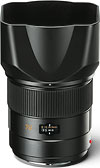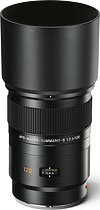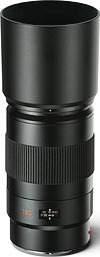Big day for Leica: Three new cameras, six lenses, and more…
posted Thursday, May 10, 2012 at 5:45 PM EDT
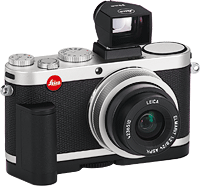 Germany's Leica Camera AG is making quite the splash today, with a surprisingly large collection of new announcements. (Well, surprising unless you've been paying attention to all the rumors and leaks in the run-up to today's 'Das Wesentliche' press event in Berlin, that is.)
Germany's Leica Camera AG is making quite the splash today, with a surprisingly large collection of new announcements. (Well, surprising unless you've been paying attention to all the rumors and leaks in the run-up to today's 'Das Wesentliche' press event in Berlin, that is.)
Probably the most significant of the announcements is the Leica M Monochrom, the world's first 35mm full-frame camera specifically for black and white photography. The M Monochrom takes most of the existing Leica M9 design, swaps in an unfiltered image sensor, and changes the processing. As with Nikon's recent D800E, the net result is a camera that should offer significantly better per-pixel sharpness, although the difference should be even greater for the M Monochrom, since it can also take demosaicing out of the equation. The lack of a color filter also translates to better sensitivity (since you're not immediately rejecting most of the light hitting the image sensor), and finer-grained noise (since demosaicing doesn't spread noise at each pixel location to its neighbors). If you're the kind of photographer who shoots exclusively in black and white, those are pretty significant advantages, and we must admit we've been hoping for some time that a manufacturer would step up to bat with a camera like the M Monochrom.
|
The Leica M Monochrom is the first 35mm full-frame camera with a monochrome sensor. Photo provided by Leica Camera AG. |
Available from July 2012, pricing for the Leica M Monochrom is set at US7,950, which puts it at almost a thousand dollars over the list price of the M9, when it was announced back in late 2009.
Perhaps of interest to a wider audience is the Leica X2. A followup to 2009's Leica X1, the X2 is nearly identical to its predecessor externally, and retains the same 24mm f/2.8 Elmarit prime lens, and rather dated 2.7-inch, 230,000 dot LCD display. The most obvious difference externally is an extra connector behind the flash hot shoe, which accepts a new electronic viewfinder accessory that resurrects the Viso-Flex brandname. (Specs for the EVF aren't yet known, but it has similar resolution to the Olympus VF-2 EVF used by some of that company's PEN-series models.) On the inside, it has a new 16 megapixel APS-C image sensor with a slight 15% increase in linear resolution over the earlier 12 megapixel chip. Beyond that, Leica says that it has also addressed autofocus performance, and doesn't call attention to any other significant changes.
|
The most notable change in the Leica X2 is support for an electronic viewfinder accessory. Photo provided by Leica Camera AG. |
Pricing for the Leica X2 has not yet been disclosed, but is rumored to be in the region of US$2,000, not dissimilar to that of the X1 before it.
Of the trio, though, the camera that's likely to reach the hands of the most photographers is the Leica V-Lux 40. A followup to last year's Leica V-Lux 30, the V-Lux 40 looks to continue the company's long tradition of releasing consumer cameras based on those from partner Panasonic. Specifically, the V-Lux 40 appears to be a rebadged and restyled Panasonic Lumix DMC-ZS20 (known in some markets as the TZ30). While the hardware appears basically identical, there may of course be differences in image processing, but the image quality of the ZS20 will likely serve as at least an approximation of what can be expected from the V-Lux 40.
|
Shown here with its optional leather case, the Leica V-Lux 40 is closely related to the Lumix DC-ZS20, a Panasonic model announced last March. Photo provided by Leica Camera AG. |
Available immediately, the Leica V-Lux 40 again has no official launch price, but is rumored to list at around US$700, double the US$350 price of the Panasonic variant.
And that's almost it, as far as the cameras go. There's one last announcement, but it's simply a new limited-edition color of the existing Leica M9-P, which itself was a slight variation on the Leica M9 with a tougher cover glass over the LCD. Continuing the company's tie-up with French fashion house Hermès, the Leica M9-P Edition Hermès replaces the vulcanized rubber covering of the standard M9-P with an ochre calfskin wrap, and includes both a matching shoulder strap and silver Leica Summilux-M 50 mm f/1.4 ASPH. The camera body itself has also been restyled by Italian designer Walter de'Silva, the current head of design at Volkswagen AG, with a limited edition production run number included on the body. A production run of 300 units worldwide will be released from June 2012, and pricing hasn't been disclosed.
|
Cover your ears, animal lovers: the Leica M9-P Edition Hermès has a calfskin covering. It also lacks the hot shoe and frame selector lever of the standard M9-P. Photo provided by Leica Camera AG. |
Just in case you feel like spending a bit more, though, you can instead opt to wait a month longer for the "Leica M9-P Edition Hermès -- Série Limitée Jean-Louis Dumas" (quite a mouthful!), which commemorates the former Hermès president who passed away in May 2010. This kit will take the base Edition Hermès body and strap, and include three lenses: the Leica Summicron-M 28 mm f/ 2 ASPH., Leica Noctilux-M 50 mm f/0.95 ASPH. and Leica APO-Summicron-M 90 mm f/ 2 ASPH. The kit will also include a matching, hand-finished Hermès camera bag, said to be the company's first, as well as a book of 200 black and white images shot by Jean-Louis Dumas on a Leica M body. The production run for this kit will be a very limited 100 units worldwide, and (you guessed it), no price has been disclosed.
|
Of the 400 M9-P Hermès kits sold, 100 will include the first Hermès camera bag, and a selection of three lenses to fill it with. Photo provided by Leica Camera AG. |
An interesting detail with the limited-edition Leica M9-P Edition Hermès body in both kits, incidentally, is that it actually offers a slightly lesser feature set than the standard edition, with the subtractions apparently made in the name of style. Notably, there's no hot shoe on the camera's top deck, making this entirely an available-light camera. There's also no longer a frame selector lever on the front panel. That's perhaps a little beside the point, though; this isn't a camera most owners will probably ever use. (And an acknowledgement of that fact can be seen in the fact that the product bundle includes a pair of gloves, to help ensure you don't mar the camera's finish in any way!)
|
The Leica APO-Summicron-M 50 mm f/2 ASPH. lens. Photo provided by Leica Camera AG. |
Also announced today were a fair selection of new optics. Starting with the M mount, we have the new Leica APO-Summicron-M 50 mm f/2 ASPH. lens, which Leica claims "[redefines] the limits of what is technically possible". It's said to have the best MTF test results ever for a Leica M lens, and is hand-assembled at Leica's factory in Solms. Availability in the US market is set for late July 2012, and street pricing is rumored to be in the region of US$7,200.
|
The Leica S-Adapter allows use of Hasselblad H-system lenses on the Leica S2 body. Photo provided by Leica Camera AG. |
For the S mount, meanwhile, there are five lenses and a mount adapter. The Leica S-Adapter H allows use of Hasselblad H-system lenses on the now rather long-in-the-tooth Leica S2 camera body, and retains all functions including autofocus, shutter and diaphragm control. It's possible to select to use either the in-lens or in-body shutter. The S-Adapter H is available immediately, with no info on pricing. The five new S mount lenses include two wide angles, and one apiece for standard, tele-macro, and telephoto. These are the Leica Elmarit-S 30 mm f/2.8 ASPH., Summarit-S 35 mm f/2.5 ASPH., Summarit-S 70 mm f/2.5 ASPH., APO-Macro-Summarit-S 120 mm f/2.5, and APO-Tele-Elmar-S 180 mm f/3.5, respectively. All include in-lens shutters rated as good for 100,000 shots, as well as dust and splashproofing. Availability is expected this October, and no prices have been disclosed.
|
Leica's new S-mount primes: 30mm, 35mm, 70mm, 120mm, and 180mm Photos provided by Leica Camera AG. |
||||
